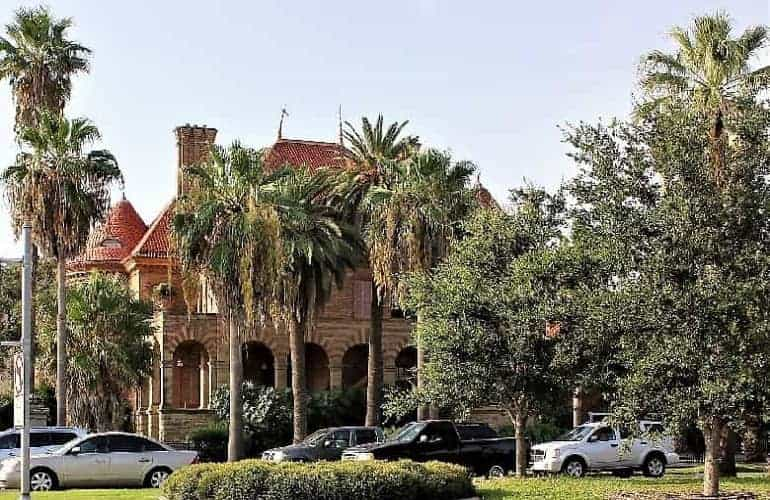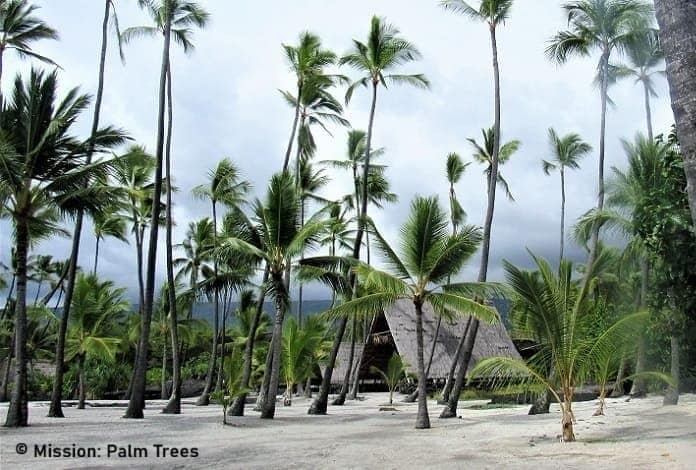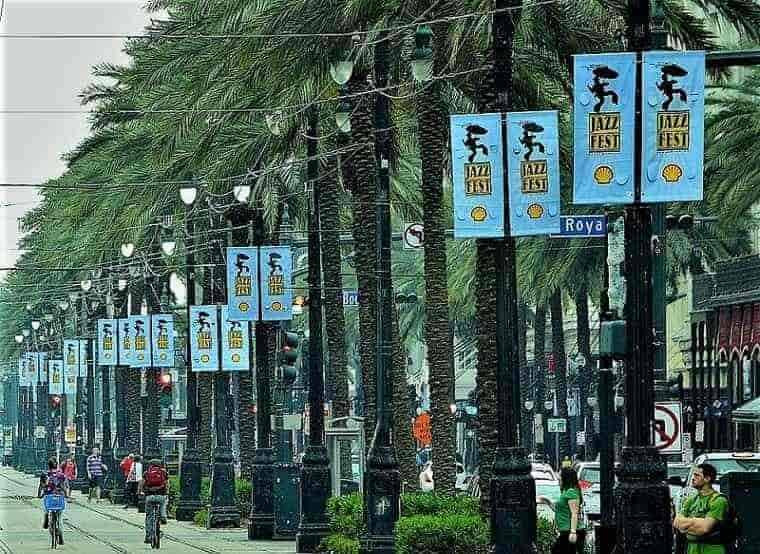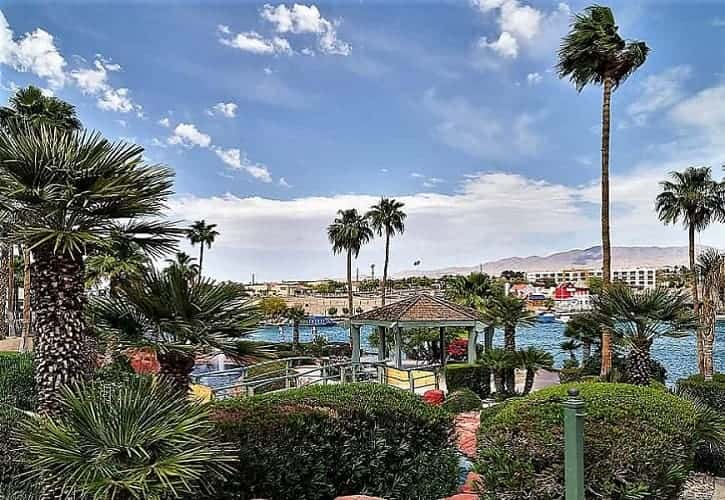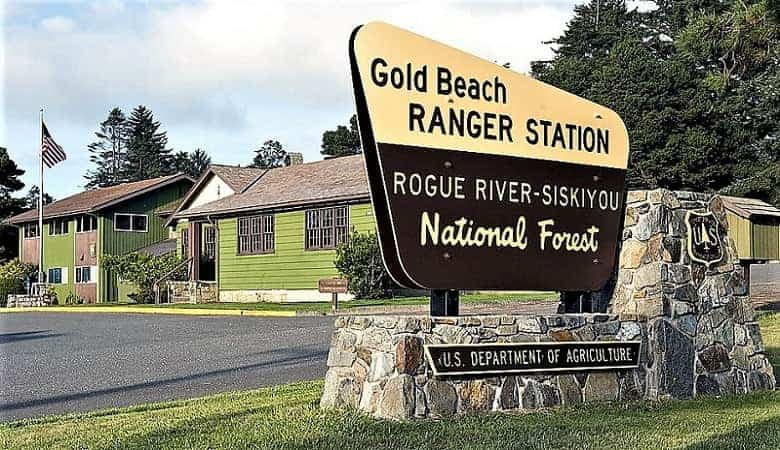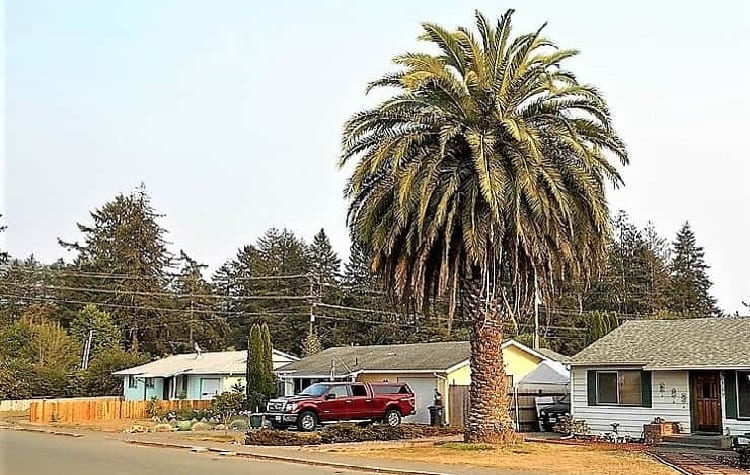- Home
- Palms in U.S.
Palm Trees in the US - Where They Really Grow
Palm trees in the US aren’t limited to Hawaii, Florida and California. They grow across many southern and coastal states.
Like with the warm Gulf Coast to the coastal areas of the Carolinas, palms naturally can grow where climates are mild enough to support them. Using USDA hardiness zone details we can map out exactly where palm trees naturally grow and survive.
Here’s a full breakdown of where they're found.
Feeling overwhelmed by so many palm trees?
You're not alone. We Understand your headaches! At Mission: Palm Trees you'll find clear answers to questions & Step-By-Step Guidance, from real people. With solutions to help. No puzzling shoptalk. No tiring research. So it's easy & fun for you.
Overview: Where Do Palm Trees Grow in the U.S.?
Some states are the most common for palm trees in the US.
Because their climate naturally suits what palm trees need. Why is that?
- Most important is a subtropical or tropical climate.
- Secondly, if temperatures ever get below freezing.
- And if temps get that low, the freeze doesn't last long.
Climate and USDA Hardiness Zones for Palms
A good map to consult for palm trees in the US is for temperature reference. The UDSA Plant Hardiness Zone Map.
Beginning with yellow tones into brownish, representing areas where palm trees in the US can grow easily. We've lined out the normally suitable zones.
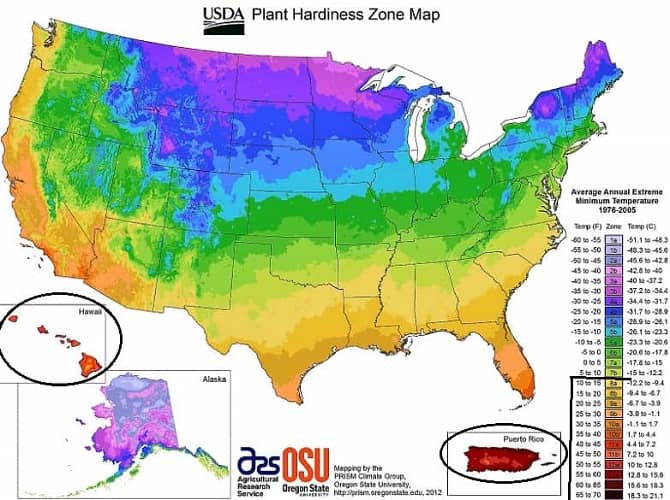 This Palm Trees in the US Map Key Shows Where Palms Grow
This Palm Trees in the US Map Key Shows Where Palms GrowWill They Be Successfully Grown?
That depends on more than this map. Right now we're speaking of survival ability, the possibility for success of any palm trees in the US - anywhere! Because adjustments can be made to accommodate a palm's needs.
Mission: Palm Trees is made possible by readers like you! If you purchase via a link/ ad here, we may earn a small commission. At no added cost to you. Thanks for your support! Learn more>
States Where Palm Trees Naturally Grow

Some U.S. states have subtropical zones, and fewer have tropical zones. All southern U.S. states bordering the Gulf of Mexico have subtropical regions.
Those are all favorable areas for growing palm trees. But exactly where depends on localized climate, soil conditions, weather, elevation, etc. Let's evaluate such states.
Florida Palm Trees
Nearly the whole state is subtropical.
The southernmost areas fall into the tropical zone. Their climate has lots of sun and rain, making for good humidity levels. With rare freezing weather, Florida is a state well suited for palms.
You'll see plenty if you Visit Miami's Downtown. Although many palms do well in Florida, remember - not all. Still check the specifics of a species' needs.
Some palms need a lot more loving care, because of their natural origin. Even in Florida. Always ask yourself: will it be the best environmental fit?
 It's a World of Tropical Palms in Miami Florida!
It's a World of Tropical Palms in Miami Florida!Just as Florida is immersed with tropical palms, Texas offers a different but still favorable climate.
Do Palms Grow in Texas?
Yes, palm trees grow in Texas.
They are most common along the Gulf Coast and in the Rio Grande Valley, where climates support palm trees in the U.S. state of Texas. Like the native species Sabal minor.
And because Texas is a huge U.S. state, with acreage only second to Alaska, it has varied climates. Giving it more palm species variety options.
Palm Trees Love Southern Texas
Especially Where Palms Can Grow along the Gulf Coast. And if you're Staying in Corpus Cristi in the Rio Grande Valley, you're sure to see palms.
Warm, humid conditions allow several species to grow naturally. Cities like Brownsville (Plan a Stay>) showcase healthy palms in landscapes and streetscapes.
Unfortunately the endemic Texas Palm (Sable mexicana) is critically endangered in Texas.
That's according to C.C. Wright at the Texas State Historical Association. Because of clearing for agricultural needs. Now, the best place to easily view it, says TX Parks/Wildlife, is at the Audubon Society's Sabal Palm Grove Sanctuary.
Farther Inland and North, Texas Becomes Less Tropical
Only specific outdoor Types of Palms generally do fine. In places such as:
- San Antonio [Fabulous Stay in This Historic City to see its palms]
- Austin is Where You'll Be to see palms growing.
- Even when Traveling to Dallas–Fort Worth, you'll see planted palms surviving.
- Don't forget getting to El Paso, which has Desert Conditions for Growing Palms.
In Texas desert areas, stick to those suited for arid climates, like the Mexican Fan Palm, Canary Island Palm & Desert Fan Palm. Why not get to The El Paso Area to See Them for yourself!
 Palms Wave Entry into the West End Historic District's: Dallas Aquarium
Palms Wave Entry into the West End Historic District's: Dallas Aquarium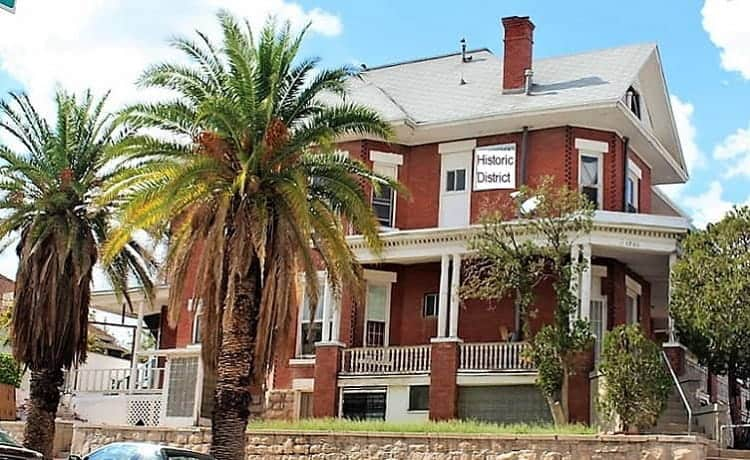 Home in Sunset Heights, El Paso, the Historic District, with nice palms out front.
Home in Sunset Heights, El Paso, the Historic District, with nice palms out front.The best palms for growing in these other areas of Texas are Those Hardy Species like the Windmill Palm or Mediterranean Fan Palm. These types of ornamental palms must be protected from occasional freezes, especially when they're young.
Once you establish them, such palms can do quite well.
🌴Summary: Texas supports both native palms in the subtropical south, cold-hardy ornamentals in its central and northern regions, and drought tolerant palms in desert areas.
Hawaii for Palm Trees
Hawaii has the ideal climate for growing humungous amounts of palm trees.
And they do!
 Tons of palms on this Hawaiian Black Sand Beach
Tons of palms on this Hawaiian Black Sand BeachBehind myself and my granddaughter.
Each Hawaiian island has its own native palms.
They're all cousins, in that they all belong to the same Genus, Pritchardia. There are over 20 species.
Besides that, many other palms were brought here.
The first Polynesians who came to Hawaii's shores brought coconut palms with them. Because they Used All Parts of Cocos nucifera, from food to building materials & clothing.
Louisiana Palm Trees
Louisiana is among the best of the Southern states for growing palm trees!
Louisiana is often sultry, humid & hot. Seldom getting cold weather, freezing temps are rare. Many areas are suited for palms. Like near These New Orleans Stays.
Where can palms grow in Louisiana?
- East to West, south of these county's northern borders: Beauregard, East Feliciana to Washington. You've got it easy.
- North of there, about Shreveport over to Bastrop, any outdoor palms need your careful wintertime watching.
- North of the above regions? You have to evaluate if it's worth the effort.
Palm Trees in Alabama
Alabamans can grow many palm tree species. Easily, pretty much with no worries.
The best area is along the Southern Coastal Panhandle on the Gulf of Mexico. So there are suitable species among palm trees in the US that can Do Well in Alabama.
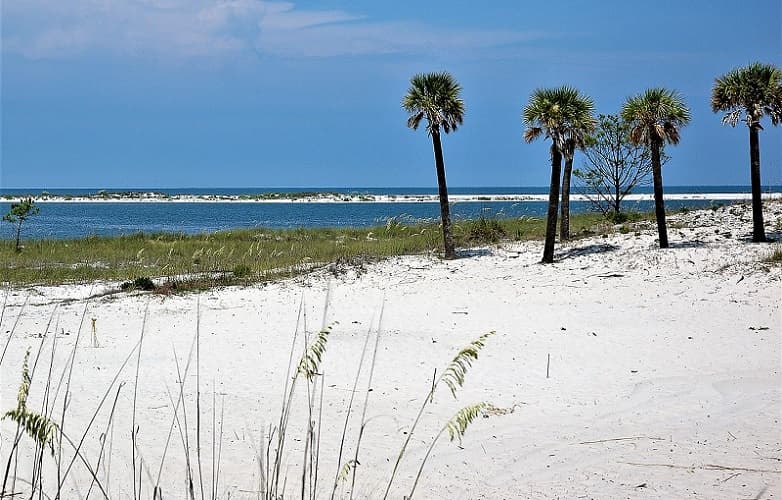 Palm Trees Along the Dunes on Daughin Island in Alabama
Palm Trees Along the Dunes on Daughin Island in AlabamaPalm Trees in Mississippi
Circumstances for growing palms over in Mississippi is similar to Alabama.
It's got a panhandle shore, well-suited for palms. Like those You'll Find in Gulfport.
- More inland, to about 20 miles north of Hattiesburg you can grow palms quite successfully.
- The next 1/3 of the state northward, growing palms won't be very easy. Your protective care will be needed!
- North of that, it's getting more hilly & chilly! Palms are possible, but you'd want to know which Palms Can Endure Some Cold Weather.
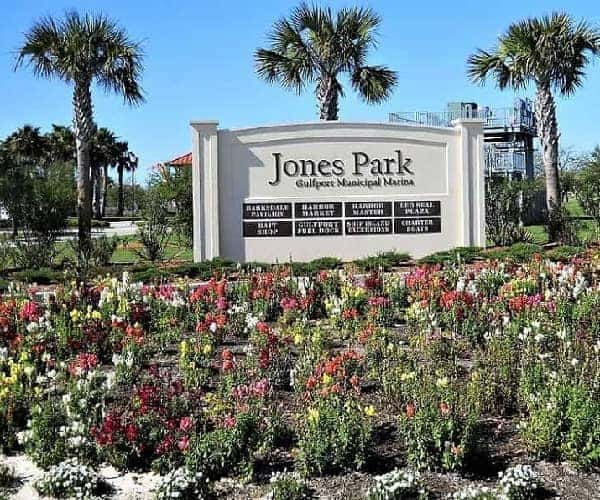 Palm Tree welcoming entrance to the Marina in Gulfport
Palm Tree welcoming entrance to the Marina in GulfportGeorgia Palm Trees
Georgia has subtropical zones along its coast.
Scrubby, sandy areas are the right place for a Georgia native palm tree. Other palm trees have been cultivated throughout Georgia, and are doing well.
The most suitable areas in Georgia for palm trees are nearest the coast. The farther south along the coast, the better for growing palms. We recommend Savannah to see lush palm varieties. Try this Beautiful Historically Influenced Spot.
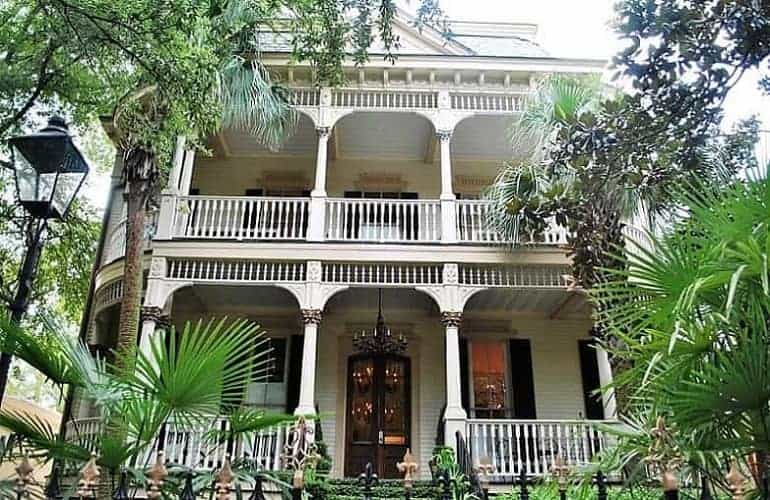 Savannah's Historic District is known for gorgeous architecture & palm landscapes.
Savannah's Historic District is known for gorgeous architecture & palm landscapes.The Carolinas - Contrasting Both North & South
Palm trees are most common along the coasts of South Carolina and southern North Carolina. The humid climate supports species like Cabbage Palmetto (it's the South Carolina state tree!) which likes scrubby environments.
Farther inland, palms are less common. Although cold-hardy varieties like the Windmill Palm survive in protected urban landscapes. Northern parts of North Carolina are generally too cold for long-term survival of outdoor palms.
🌴 Summary: In the Carolinas, palms thrive on the coast but require cold-hardy species inland, with little chance of survival farther north.
South Carolina Palm Trees
When going Inland, Surrounding Charleston, you'll find growing palms can be done.
Ideal areas are along the coast. Suitable growing zones, like here, show South Carolina is a Good Palm Growing State.
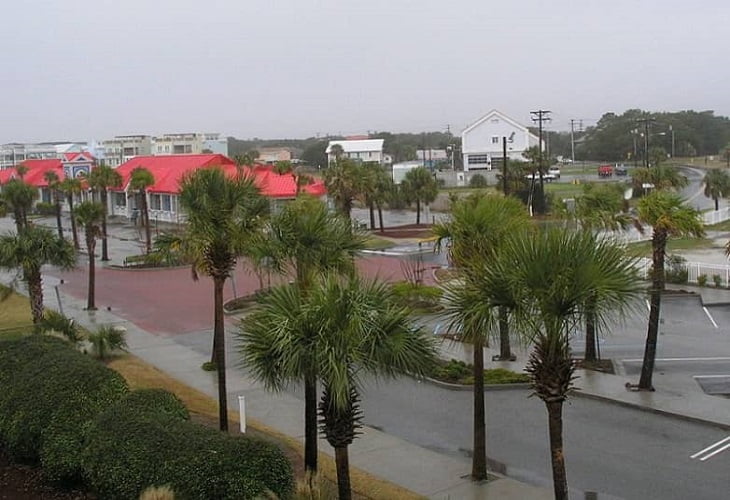 Isle of palms in South Carolina - Sounds like a place for palm trees!
Isle of palms in South Carolina - Sounds like a place for palm trees!Do Palm Trees Grow in North Carolina?
We wondered if palms can grow In the Outer Banks at Manteo NC. When visiting our cousin there, we've looked for them in sandy, scrubby coastal areas. But no luck so far.
But this example in This Beachside Town, next to Wilmington, NC's Southernmost City, is a place Where Palms Grow in North Carolina.
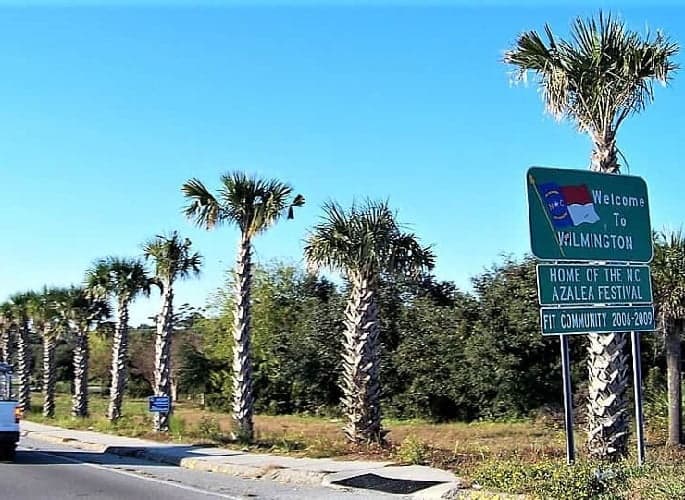 You're welcomed to Wilmington North Carolina, with palms!
You're welcomed to Wilmington North Carolina, with palms!Palm Trees in the US - Southwestern States
Mainland southwestern states have regions in the subtropical range.
But because of the Sierra Nevada & Rocky Mountains, plus mountain islands in southwestern states, growing palm trees is quite variable. Climates change as elevations rise. The higher the elevation, the more difficult it is to grow palm trees!
The Köppen-Geiger Classification system of climate divisions calculates more than just temperatures over the years. It includes how dry & hot OR how dry & cold an area has been & much more. All analyzing climate varieties in western & southwestern states.
Palms in Arizona - The Desert Southwest
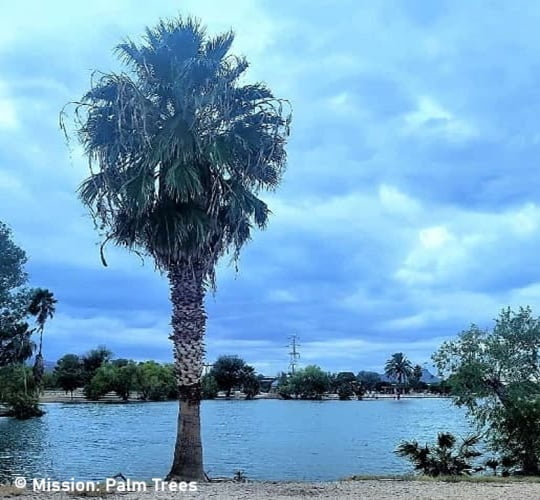 Palms in Christopher Columbus Park, near our home.
Palms in Christopher Columbus Park, near our home.We've seen people asking: does Arizona Have Palm Trees? Desert Fan Palms, Canary Island Palms, Mexican Fan Palms and Queen Palms are all around Tucson, Arizona where we live. These Palms in the Sonoran Desert grow well.
- There's a fantastic Botanical Garden here. And we recommend This Nearby Stay We Reviewed from our wedding anniversary staycation.
- There's another garden you should see, Tohono Chul. This Stay Nearby is highly recommended (I've only been there for conferences). We'll choose it for a future Staycation.
Plenty of places we've seen in our Arizona travels have many palms. Cities such as:
- Phoenix Arizona has plenty of arid-tolerant palm trees.
- Yuma AZ has palms along the Colorado River & on some properties.
- Bullhead City has palm trees (recommending this). It's across the Colorado River from a fun place: Laughlin Nevada.
- Kingman AZ & Lake Havasu City both have plenty of palm trees!
Palms in New Mexico
From high desert to mountains, New Mexico has the southernmost part of the U.S. Rockies.
But NM palms are most likely seen in the state's lowest elevations.
- The southeast corner, at about 2400+ ft., and in the panhandle.
- Also think along the Rio Grande.
- Even to Silver City, which has a bit higher elevations than lower Chihuahuan deserts.
For instance Las Cruces is a Nice Small City for Palms. We've Stayed Here, Right Off I-10, while on our way East. It was fine (even if we weren't attending a conference), especially for a budget-friendly rate.
Nevada Has Palm Trees - Las Vegas Area
Been to Vegas?
Then you know there are palm trees galore there! They get a rare winter snowstorm, but it melts fast.
Think of the Nevada map. The southern triangle of the state has most of the population. And the majority of palms.
- In Las Vegas, In Lower-Key Henderson, or Laughlin For the River & Palms.
- And maybe over to Lake Mead areas.
All these Nevada areas are where palms do best. Northerly areas and higher elevations into mountains typically won't work.
Palm Trees in Utah
Southern border areas in Utah have much success with palms. Lower deserts, like areas Surrounding St. George, have success growing drought-favorable palms.
But northward in these southern desert areas, the elevation rises. Then growing palm trees becomes more difficult, if not impossible.
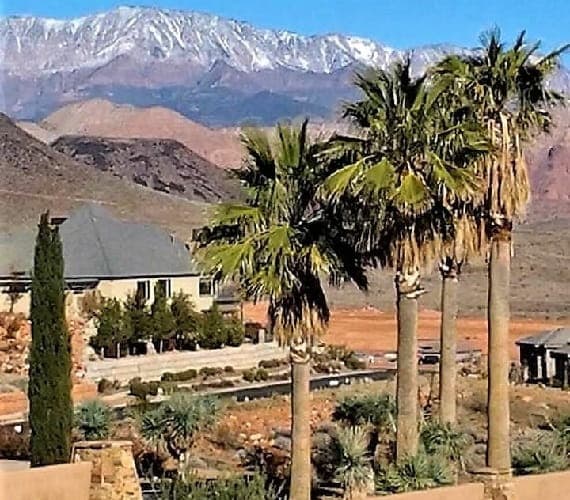 St. George Utah has palm trees for a tropical atmosphere.
St. George Utah has palm trees for a tropical atmosphere.While viewing snowcapped peaks in the Pine Valley Mountains
Can Palm Trees Grow in Oklahoma?
Not the ideal climate.
Our granddaughter lives in the Tulsa area. When we've visited we've never glimpsed a palm in The Tulsa Oklahoma Area. But through the grapevine we've heard of some doing fine outdoors.
The most friendly climate for palms in Oklahoma is in the state's southeast corner. Call it the most palm-friendly OK climate!
We've seen palms growing in Oklahoma City.
- At the OK City Zoo You Can Visit Them!
- And one more place here:
Palm Trees in the US in California
California is enormous in size & varieties of climates.
From the lowest low (Death Valley), to the highest high (Sierra Nevada Mountains). From arid areas to piney rain forest. Except for mountain elevations, many varieties of palms trees grow.
Southern California is actually a desert. Meaning drought-tolerant palms do fine. The farther north you go, the more important it is to note a palm's cold tolerance.
- All throughout Southern California Palms grow. Multiple types. From deserts inland to ocean shores. Like those Lofty Palms Seen in Los Angeles.
- Sometimes palms are found in surprising areas. The Central Valley has palm trees growing as far north as the Town of Corning - where we've seen one. The farther north you go, the less you'll find.
Along coastal areas, palms grow from the Southernmost Imperial Beach, up to Newport in Mendocino County. Possibly even further north.
Go to San Diego or Los Angeles you'll see palm trees. Northern coastal areas don't get freezes very often. That helps! But the farther South the better, and the more coastal the better.
Just Like San Diego (We Think it's the Best to observe palms!)
The Latest at MPT
-
Backyard Palm Tree Ideas Make Your Space Feel Like a Tropical Escape
Bring a resort feel home. Explore inspiring backyard palm tree ideas with themes like clustering, layering, and lighting designs for any space.
Other United States Regions with Palms
Palm trees in the US can grow in other states, too.
Some may surprise you! In these states, successful palm growth depends on an area's microclimate, how far north, coastal or not, elevation above sea level, and typical weather.
We've evaluated these other US states where you'll discover palms are doing fine.
Palm Trees in Arkansas
Are you willing to try? Then you can plant palm trees in Arkansas. Best with cold-tolerant types. With careful oversight in winter.
Put in work & attention to Give Your Palms a Successful Life.
The southeastern corner of the state is your best bet. Think from south of I-40, across from Memphis, Into Little Rock, then southeast of I-30. With climates palms could adjust to.
You can see Austin's showing you where it's been done in Little Rock...
Welcome to Oregon - Let's Search for Palms
Coastal areas are the best bet for growing palm trees in Oregon.
Where freezing temps occur the least, and last the shortest time. It's the warmest, wettest climate of the state. Yes, plenty of rain. Your optimal type of palm is the cold-tolerant species.
Do you know where palm trees grow in Oregon? They're in Reedsport on the Coast. We've also discovered palms in Portland (we always enjoy going there), And You Can Too>
Somebody Knows About This One...
Palm Trees in Washington State
Coastal areas are the place for palms.
That includes Puget Sound Coasts. Conditions are similar to Oregon. Except for interior sections of Olympic Peninsula. And we hear there are palms in the Seattle area.
Here's one example. Not in Seattle, but in Southern Washington near the Columbia River.
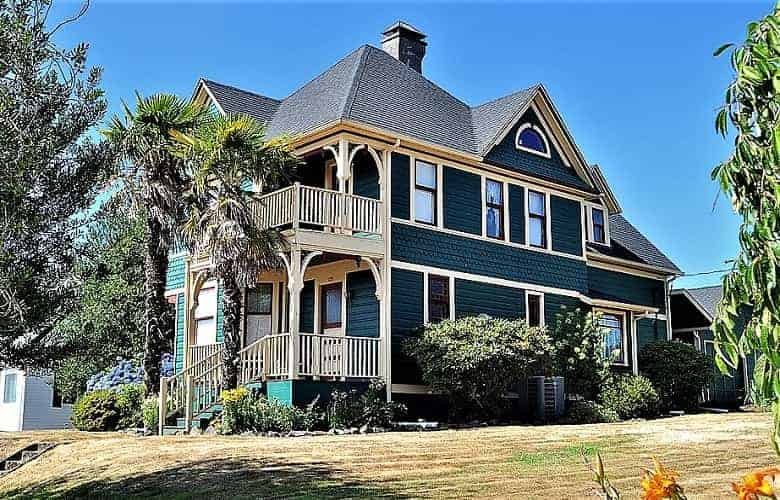 Queen Anne House in Cathlamet Washington welcomes visitors with entryway Palm Trees!
Queen Anne House in Cathlamet Washington welcomes visitors with entryway Palm Trees!FAQ About Palm Trees in the US
What is the northernmost state with palm trees?
What is the northernmost state with palm trees?
Palms grow in the Washington State and in Oregon. I've heard of palms doing well outdoors in places like New York and New Jersey. And I've seen discussions on Palm Talk that even Minnesota has some palms growing! Pretty amazing.
The northernmost limits of palm growth can be difficult to define. It depends on many factors such as palm species' toleration to low temperatures, and the protective care palms are given to get them through very cold weather.
Do palm trees grow naturally in the U.S.?
Do palm trees grow naturally in the U.S.?
Yes, many species of palm trees grow naturally in the U.S.
Many states have palms that are endemic. Examples are:
- Royal Palms (Roystonea regia), native to southernmost Florida.
- Texas Palm (Sabal mexicana) naturally flourished in South Texas, but is now a threatened species.
- Dwarf Palmetto (Sabal minor) has always grown in the southeastern U.S. But also in suitable areas of Texas, Oklahoma & Arkansas.
- Cabbage Palm (Sabal palmetto) is indigenous from southernmost North Carolina on down through Florida.
Can palm trees survive in cold climates?
Can palm trees survive in cold climates?
Yes, hardy palms do just fine in some colder climates.
Species like Trachycarpus fortunei, Sabal palmetto, Trithrinax brasiliensis and Rhapidophyllum hystrix are known to tolerate lower temperatures than most palms.
Their cold-hardiness becomes established once they're over a year old. Before that, they'll need protective coverings for any cold spells.
The Range of Palm Trees in the US - Takeaways
Quick takeaway: Palm trees in the U.S. love warm coastal areas and southern states, where they do well. Southwestern states of the U.S. grow many drought-friendly species. But some hardy species can survive surprisingly far north.
Palm trees in the US are not limited to the tropics. In the United States, they grow naturally and ornamentally across Florida, the Gulf Coast, southern Texas, southern California, coastal areas of the Southeast, and desert areas of the southwest.
Hawaii is the perfect place for tropical palm species. Cold-hardy palms do well as far north as the Carolinas. The desert Southwest is a good place for arid palm species.
While their range is Defined by Hardiness Zones and climate, palms bring a distinctive, tropical feel wherever they grow.
